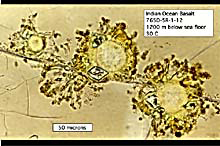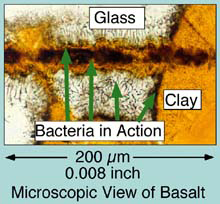
This basalt microbe shows unaltered volcanic glass, this time with a crack running through it and some round holes that formed when the lava was molten. Bacterial holes radiate from the round holes and from the crack. Diamond shaped minerals (olivine) do not appear to be affected by the bacteria. Click image for larger view.
Microbes in Oceanic Basalt
Martin Fisk, Ph.D., Professor
College of Oceanic and Atmospheric Sciences
Oregon State University
Microbes live in most environments where water is present and the temperature is less than 100°C. Other requirements for life are carbon, essential nutrients, such as phosphorus and nitrogen, and a source of energy. For most organisms the sun is the primary source of life sustaining energy, but some microbes use the chemical energy of the earth to sustain them. One example is the microorganism that combines oxygen and hydrogen sulfide within the gut of tubeworms at hydrothermal vents
Bacteria have evolved to scavenge chemical energy from many types of materials, and volcanic rocks from the deep sea appear to be one of these materials. A vast part of the ocean floor is composed of basalt that has erupted on mid-ocean ridge volcanoes or on isolated volcanoes that form seamounts. Microorganisms appear to attack these volcanic rocks.

Microbes are key to the creation of oceanic volcanic rocks. This image shows the volcanic glass (white) that formed as lava erupted into the ocean. Clay (orange) has formed from by the action of bacteria on the glass. The dark zone between the white and the orange is where the microbes are active. Also, filaments of black can be seen where microbes have made their way into the volcanic glass.
Click image for larger view.
This raises many questions, such as: how do microbes dissolve the rocks, do the microbes obtain nutrients from the rocks, and do they obtain energy from the rocks?
Our objectives on this cruise are to determine the abundance of microbes in the volcanic rocks of different ages and to determine what microbes are present. We will start cultures on the ship to grow the microbes because this is currently the best way to determine how and why the microbes attack the rocks. We will collect rocks from several old volcanic seamounts to inoculate our cultures. The cultures will be sampled and analyzed after we transport them to our laboratory at Oregon State University.
The habitats in volcanic rocks that microbes occupy on earth may be duplicated on other planetary bodies. Microbes that are capable of living in the deep ocean rock could potentially live in subsurface environments on Mars.
Sign up for the Ocean Explorer E-mail Update List.


























